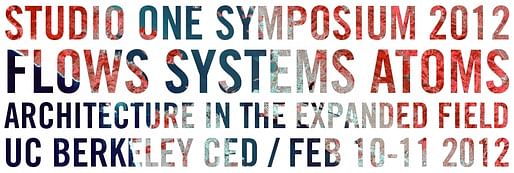

from the symposium website...
"The Inaugural Studio One Symposium will be held February 10-11, 2012. Focusing on the studio's themes of architectural agency at an ecological and infrastrucutral scale, the symposium will bring together a global roster of influential designers and thinkers for two days of design, discussion, and debate.
MORE ON STUDIO ONE
To paraphrase Bill McKibben’s 1985 description of New York, the San Francisco Bay has as much to do with nature as a cow has to do with Cool-Whip. Instead of “nature” per se, the bay is a complex assemblage of manifold systems, few of them classically natural, and yet all of them, often invisibly, contributing to our own, architectural occupation of the landscape. However – as with the cool-whip – our own desires for landscapes like the bay would too-often submerge these manifold relationships in favor of something that looks exactly like “nature,” while actually being nothing of the kind.
From the effects of hydraulic mining in the 19th century, through the combined effects of bay fill in the 20th, to the de-industrialized brownfields of the early 21st, the San Francisco Bay is an exemplary crucible of the often-fraught relationship between cities and the larger ecology that support them. And as the margin’s of today’s bay begin — often laudably — to be returned to a “natural” state through extensive man-made remediation, the 2011-2012 Studio One seeks to question whether the bay can also be a new vessel, of a new kind of relationship between cities and ecologies; one that emphasizes the reciprocal nature of the relationship between urban civilization and natural wild, and avoids the oversimplifications, in a manmade or “natural" context, of reflexive “preservation.” In doing so, we would hope to heed the warning offered by landscape historian William Cronon in his essay “The trouble with Wilderness, or getting back to the wrong nature.”
…Our challenge is to stop thinking of such things according to a set of bipolar moral scales in which the human and the nonhuman, the unnatural and the natural, the fallen and the unfallen, serve as our conceptual map for understanding and valuing the world. Instead, we need to embrace the full continuum of a natural landscape that is also cultural, in which the city, the suburb, the pastoral, and the wild each has its proper place, which we permit ourselves to celebrate without needlessly denigrating the others.
Since beginning a year-long consideration of the bay, and architecture’s shifting role in it, the students of Studio One have engaged in a series of mapping and analysis exercises, narrowing their focus to hundreds of brownfield, abandoned, or marginal sites along the bay’s miles of coastline. Using techniques and software developed by Nicholas de Monchaux for the Local Code project, students will prepare a parametric site study of each site, culminating in a final presentation on May 4, 2012."
Architecture Research Lab specializes in design and construction technology and is located in Berkeley, California - www.archresearchlab.com



No Comments
Block this user
Are you sure you want to block this user and hide all related comments throughout the site?
Archinect
This is your first comment on Archinect. Your comment will be visible once approved.